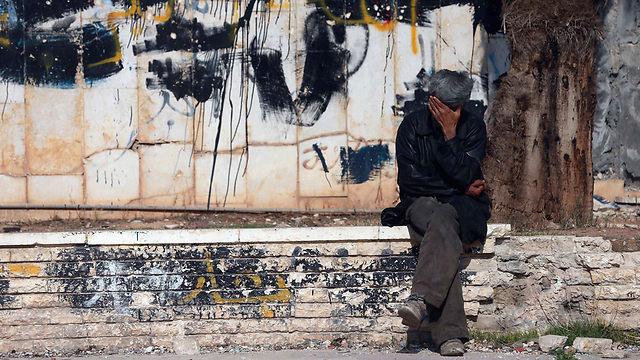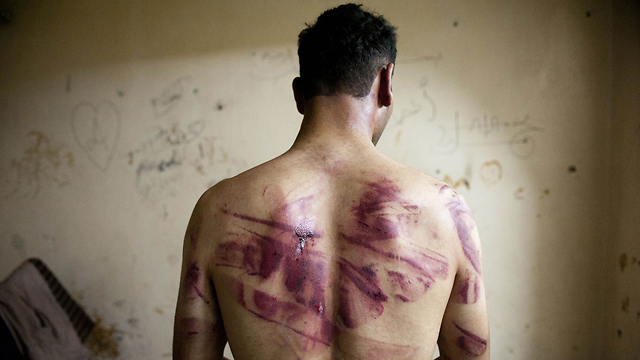
Responses on social media swung between anger towards the humiliation of Muslims in the US prison at Guantanamo Bay, and criticism of similar practices in the Arab world, in particular by the Syrian state. The torture methods reminded many survivors of their treatment in the prisons of the Assad regime, as well as detention facilities run by the Islamic State.
'Light' CIA torture
Some on social media pointed to the fact that numerous Arab governments used the same or similar torture methods.
"Many stupid Arabs are enraged by the CIA torture report, but they forget that Arab governments tortured them too," wrote one Twitter user.
"Are those horrified by the report equally horrified by reports of Arab countries on whose soil the torture occurred?" asked an Egyptian commenter.
"Arabs, let me understand," wrote a Syrian user on Twitter. "This type of 'light torture' such as sleep depravation is considered a big deal in civilized countries."
Another user posted a picture of Bashar Assad, imagining him reading the torture report and saying, "you know nothing about torture."
Interviews with survivors have exposed the brutality of Syria's secret prisons - which the Islamic State has used as a prototype.
Mohsen al-Masri spent two years being dragged between prisons controlled by the Syrian security services. He suffered severe beatings and was hanged from the ceiling for several hours.
One of the worst horrors he experienced came when his guards started spraying insect repellent in his cell.
"Cockroaches started coming out of everywhere," Masri said. "They walked on our faces. The wardens put them inside our clothes."
Masri was one of the former detainees in Syria's prison underworld. He described a world of torture that was not only barbaric but also systematic.
Survivors and lawyers estimated that Syria held around 200,000 people in more than 100 detention centers since the beginning of its civil war. According to the Syrian Observatory for Human Rights, up to 12,000 people have died in these prisons.
Mohammed Samaan, a 33-year-old activist from Damascus, recalled that in the first days of the uprising against Assad he read George Orwell's 1984, a dystopian novel describing life under a totalitarian dictatorship, .
"When I became a detainee myself, I discovered that there is such a world, and it is in Syria," he said.
"Nothing, no story I read or heard, could have prepared me for the horror of detention," added Samaan, who now lives in Beirut. he said he was jailed twice for activism against Assad's regime, enduring physical and psychological torture on both occasions.
He says that an interrogator at one of Damascus's feared security branches told him: "We torture people because we are sadists. We enjoy torturing people." Samaan said that the interrogator then electrocuted him and told him to write down everything he knew. "He tried everything to break me. I have never been so terrified in my life," he said.
Masri, 36, says he also endured psychological torture."They insulted my wife, and told me they would go to my house and rape her," he recalled.
At the cells where the detainees were first held for questioning, there were severe shortages of water, food, and medicine. Masri weighed more than 220 pounds when he was first arrested. By the time of his release, he had lost more than half his body weight.
Like most detainees who spoke to Agence France-Presse under false names, Samaan and Masri were transferred from secret detention in Damascus to Adra and Saydnaya prisons after trials they dismissed as a "farce".
Those who survived the detention said they would never forget the suffering they endured. "Memories come back to haunt me every day, when I eat, when I sleep," said Samaan. "It was so terrible in there. There are things I can't even talk about."
Last June, Assad issued an unprecedented order granting amnesty to tens of thousands of people detained under Syria's notorious anti-terrorism law. But only a handful of prisoners of conscience have been released.
Islamic State learns from Assad
Meanwhile, as the horrors of Assad's dark dungeons continue to unfold, survivors of the Islamic State's detention centers told of the torture methods their captors co-opted from the Syrian state.
The array of appalling techniques is so widespread that they acquired nicknames. The "flying carpet" was a method in which the victim is strapped to a hinged board, with the ends brought towards each other, bending the spine. The technique dubbed "the tire" involved the victim being placed inside a large tire and mercilessly beaten. The Daily Mail said these two methods were practiced for years by the Syrian regime.
Activists from Raqqa, an Islamic State stronghold in Syria, revealed that they were tortured by a method called "shabeh", which means "ghost" in Arabic. The victim's hands were handcuffed behind his back, after which he was hanged by the arms, causing enormous pressure on the shoulder sockets. Activist Jimmy Shahinian was tortured by this method every four days for four months, until his arms popped out of their sockets. Richard Spencer, a reporter for the Telegraph living in Turkey, said it took four months for sensation to return to Shahinian's hands.
"All you think about is the pain," said Hazm al-Hussein, who suffered this treatment. "You can't think about anything else. You just have to be patient: if you get angry, they will take your head off. You know they want it to happen." Al-Hussein said that he was hung by his hands for three days in Islamic State custody. When he was detained two years ago by the Syrian government, he was tortured with the "tire" method.
Amnesty International described the extent of torture in Islamic State prisons as "chilling". The human rights group said the "shabeh" was used in Syria for years, that is, even before the Islamic State took control of large swathes of the country.
Some Islamic State supporters appeared to claim that the CIA torture outlined in the new report was worse than the treatment the fundamentalist group handed out to its prisoners.
"Brothers, read the Senate report," wrote one on Twitter a week after the CIA report was released. "Shove a shoe into the mouths of those who claim that the Islamic State distorts Islam."
Another supporter from Syria wrote that "beheading is one hundred times more humane and respectable than the torture these scumbags did to Muslims."



















